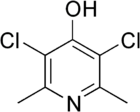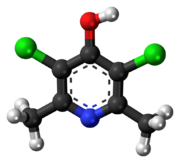Chemistry:Clopidol
From HandWiki
Short description: Chemical compound
 | |
 | |
| Clinical data | |
|---|---|
| Trade names | Coyden, Clobek(Animate Animal Health) |
| AHFS/Drugs.com | International Drug Names |
| ATCvet code | |
| Identifiers | |
| |
| CAS Number | |
| PubChem CID | |
| ChemSpider | |
| UNII | |
| KEGG | |
| ChEMBL | |
| Chemical and physical data | |
| Formula | C7H7Cl2NO |
| Molar mass | 192.04 g·mol−1 |
| 3D model (JSmol) | |
| |
| |
| | |
Clopidol is an organic compound that is used as in veterinary medicine as a coccidiostat. It is prepared industrially by a multistep process from dehydroacetic acid.[1]
The US National Institute for Occupational Safety and Health has set a recommended exposure limit (REL) for clopidol at 10 mg/m3 TWA (time-weighted average) for total exposure, 5 mg/m3 TWA for respiratory exposure, and 20 mg/m3 for short-term exposure. The Occupational Safety and Health Administration has set a permissible exposure limit (PEL); the respiratory PEL is the same as the REL, but the total exposure limit is 15 mg/m3.[2]
References
- ↑ "Ketenes". Ullmann's Encyclopedia of Industrial Chemistry. Weinheim: Wiley-VCH. June 2000. doi:10.1002/14356007.a15_063. ISBN 3527306730.
- ↑ "Clopidol". NIOSH. https://www.cdc.gov/niosh/npg/npgd0143.html.
 |

